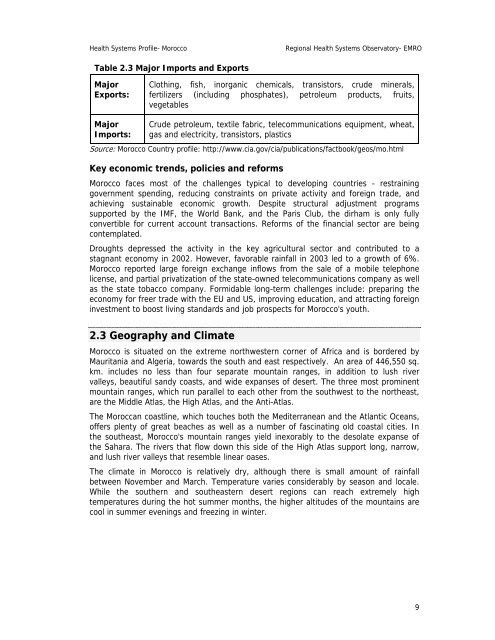2 SOCIO ECONOMIC GEOPOLITICAL MAPPING - What is GIS
2 SOCIO ECONOMIC GEOPOLITICAL MAPPING - What is GIS
2 SOCIO ECONOMIC GEOPOLITICAL MAPPING - What is GIS
You also want an ePaper? Increase the reach of your titles
YUMPU automatically turns print PDFs into web optimized ePapers that Google loves.
Health Systems Profile- Morocco Regional Health Systems Observatory- EMRO<br />
Table 2.3 Major Imports and Exports<br />
Major<br />
Exports:<br />
Major<br />
Imports:<br />
Clothing, f<strong>is</strong>h, inorganic chemicals, trans<strong>is</strong>tors, crude minerals,<br />
fertilizers (including phosphates), petroleum products, fruits,<br />
vegetables<br />
Crude petroleum, textile fabric, telecommunications equipment, wheat,<br />
gas and electricity, trans<strong>is</strong>tors, plastics<br />
Source: Morocco Country profile: http://www.cia.gov/cia/publications/factbook/geos/mo.html<br />
Key economic trends, policies and reforms<br />
Morocco faces most of the challenges typical to developing countries - restraining<br />
government spending, reducing constraints on private activity and foreign trade, and<br />
achieving sustainable economic growth. Despite structural adjustment programs<br />
supported by the IMF, the World Bank, and the Par<strong>is</strong> Club, the dirham <strong>is</strong> only fully<br />
convertible for current account transactions. Reforms of the financial sector are being<br />
contemplated.<br />
Droughts depressed the activity in the key agricultural sector and contributed to a<br />
stagnant economy in 2002. However, favorable rainfall in 2003 led to a growth of 6%.<br />
Morocco reported large foreign exchange inflows from the sale of a mobile telephone<br />
license, and partial privatization of the state-owned telecommunications company as well<br />
as the state tobacco company. Formidable long-term challenges include: preparing the<br />
economy for freer trade with the EU and US, improving education, and attracting foreign<br />
investment to boost living standards and job prospects for Morocco's youth.<br />
2.3 Geography and Climate<br />
Morocco <strong>is</strong> situated on the extreme northwestern corner of Africa and <strong>is</strong> bordered by<br />
Mauritania and Algeria, towards the south and east respectively. An area of 446,550 sq.<br />
km. includes no less than four separate mountain ranges, in addition to lush river<br />
valleys, beautiful sandy coasts, and wide expanses of desert. The three most prominent<br />
mountain ranges, which run parallel to each other from the southwest to the northeast,<br />
are the Middle Atlas, the High Atlas, and the Anti-Atlas.<br />
The Moroccan coastline, which touches both the Mediterranean and the Atlantic Oceans,<br />
offers plenty of great beaches as well as a number of fascinating old coastal cities. In<br />
the southeast, Morocco's mountain ranges yield inexorably to the desolate expanse of<br />
the Sahara. The rivers that flow down th<strong>is</strong> side of the High Atlas support long, narrow,<br />
and lush river valleys that resemble linear oases.<br />
The climate in Morocco <strong>is</strong> relatively dry, although there <strong>is</strong> small amount of rainfall<br />
between November and March. Temperature varies considerably by season and locale.<br />
While the southern and southeastern desert regions can reach extremely high<br />
temperatures during the hot summer months, the higher altitudes of the mountains are<br />
cool in summer evenings and freezing in winter.<br />
9
















